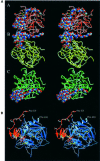Crystal structure of the human alpha-thrombin-haemadin complex: an exosite II-binding inhibitor
- PMID: 11060016
- PMCID: PMC305786
- DOI: 10.1093/emboj/19.21.5650
Crystal structure of the human alpha-thrombin-haemadin complex: an exosite II-binding inhibitor
Abstract
The serine proteinase alpha-thrombin plays a pivotal role in the regulation of blood fluidity, and therefore constitutes a primary target in the treatment of various haemostatic disorders. Haemadin is a slow tight- binding thrombin inhibitor from the land-living leech Haemadipsa sylvestris. Here we present the 3.1 A crystal structure of the human alpha-thrombin- haemadin complex. The N-terminal segment of haemadin binds to the active site of thrombin, forming a parallel beta-strand with residues Ser214-Gly216 of the proteinase. This mode of binding is similar to that observed in another leech-derived inhibitor, hirudin. In contrast to hirudin, however, the markedly acidic C-terminal peptide of haemadin does not bind the fibrinogen-recognition exosite, but interacts with the heparin-binding exosite of thrombin. Thus, haemadin binds to thrombin according to a novel mechanism, despite an overall structural similarity with hirudin. Haemadin inhibits both free and thrombomodulin-bound alpha-thrombin, but not intermediate activation forms such as meizothrombin. This specific anticoagulant ability of haemadin makes it an ideal candidate for an antithrombotic agent, as well as a starting point for the design of novel antithrombotics.
Figures








Similar articles
-
Characterization of the residues involved in the human alpha-thrombin-haemadin complex: an exosite II-binding inhibitor.Biochemistry. 2002 Feb 26;41(8):2535-42. doi: 10.1021/bi011605q. Biochemistry. 2002. PMID: 11851400
-
From haemadin to haemanorm: Synthesis and characterization of full-length haemadin from the leech Haemadipsa sylvestris and of a novel bivalent, highly potent thrombin inhibitor (haemanorm).Protein Sci. 2023 Dec;32(12):e4825. doi: 10.1002/pro.4825. Protein Sci. 2023. PMID: 37924304 Free PMC article.
-
Isolation, sequence analysis, and cloning of haemadin. An anticoagulant peptide from the Indian leech.J Biol Chem. 1993 Apr 25;268(12):8590-5. J Biol Chem. 1993. PMID: 8473305
-
Thrombin inhibition by hirudin: how hirudin inhibits thrombin.Haemostasis. 1991;21 Suppl 1:27-31. doi: 10.1159/000216259. Haemostasis. 1991. PMID: 1894193 Review.
-
Leech-derived thrombin inhibitors: from structures to mechanisms to clinical applications.J Med Chem. 2010 May 27;53(10):3847-61. doi: 10.1021/jm901743x. J Med Chem. 2010. PMID: 20155915 Review. No abstract available.
Cited by
-
Identification and Mechanistic Analysis of a Novel Tick-Derived Inhibitor of Thrombin.PLoS One. 2015 Aug 5;10(8):e0133991. doi: 10.1371/journal.pone.0133991. eCollection 2015. PLoS One. 2015. PMID: 26244557 Free PMC article.
-
Make it double: identification and characterization of a Tandem-Hirudin from the Asian medicinal leech Hirudinaria manillensis.Parasitol Res. 2022 Oct;121(10):2995-3006. doi: 10.1007/s00436-022-07634-0. Epub 2022 Aug 25. Parasitol Res. 2022. PMID: 36006484 Free PMC article.
-
Unique thrombin inhibition mechanism by anophelin, an anticoagulant from the malaria vector.Proc Natl Acad Sci U S A. 2012 Dec 26;109(52):E3649-58. doi: 10.1073/pnas.1211614109. Epub 2012 Dec 5. Proc Natl Acad Sci U S A. 2012. PMID: 23223529 Free PMC article.
-
On scaffold hopping: challenges in the discovery of sulfated small molecules as mimetics of glycosaminoglycans.Bioorg Med Chem Lett. 2013 Jan 1;23(1):355-9. doi: 10.1016/j.bmcl.2012.10.079. Epub 2012 Oct 24. Bioorg Med Chem Lett. 2013. PMID: 23164711 Free PMC article.
-
Exosite Binding in Thrombin: A Global Structural/Dynamic Overview of Complexes with Aptamers and Other Ligands.Int J Mol Sci. 2021 Oct 6;22(19):10803. doi: 10.3390/ijms221910803. Int J Mol Sci. 2021. PMID: 34639143 Free PMC article. Review.
References
-
- Arocas V., Zingali,R.B., Guillin,M.-C., Bon,C. and Jandrot-Perrus,M. (1996) Bothrojaracin: a potent two-site-directed thrombin inhibitor. Biochemistry, 35, 9083–9089. - PubMed
-
- Barton G.J. (1993) ALSCRIPT: a tool to format multiple sequence alignments. Protein Eng., 6, 37–40. - PubMed
-
- Betz A., Hofsteenge,J. and Stone,S.R. (1992) Interaction of the N-terminal region of hirudin with the active-site cleft of thrombin. Biochemistry, 31, 4557–4562. - PubMed
-
- Bode C., Nordt,T.K. and Runge,M.S. (1994) Thrombolytic therapy in acute myocardial infarction—selected recent developments. Ann. Hematol., 69, S35–40. - PubMed
-
- Bode W. and Huber,R. (1992) Natural protein proteinase inhibitors and their interaction with proteinases. Eur. J. Biochem., 204, 433–451. - PubMed
Publication types
MeSH terms
Substances
LinkOut - more resources
Full Text Sources
Other Literature Sources

